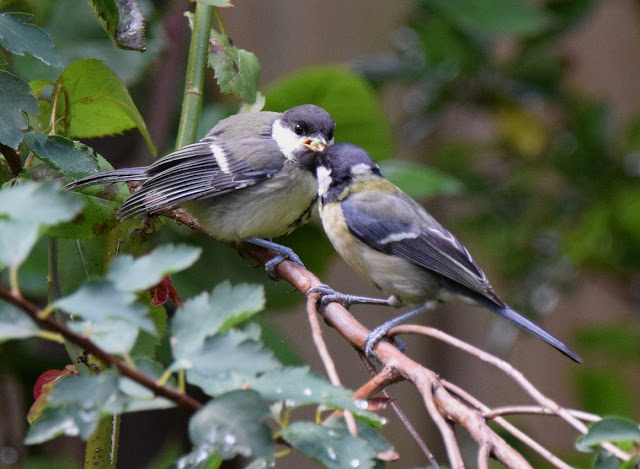The Safari was able to get the moth trap out the other night. Again it was only with the 'little' lamp and brought a total of just eight species and 26 individuals of those 16 were Heart & Darts! But there were a couple of new ones for the garden this year.
 |
| Chrysoteuchia culmella |
 |
| Small Magpie |
 |
| Clouded Bordered Brindle - nearly escaped! |
 |
| Common Marbled Carpet |
One of the Heart & Darts was almost melanistic, one of the darkest we've ever seen and another was extremely well marked
 |
| The well marked Heart & Dart |
 |
| Dark Arches |
Just after lunchtime we headed for the coast to look for the Bottlenose Dolphins again but the rain started half way there and got heavier and heavier so we aborted and returned to Base Camp to watch the feeders for the rest of the afternoon.
This morning started cool, cloudy and rather windy but at least it was dry. From the bathroom we could see a small dark blob on the water tower up the hill we've not seen for a long time, a check with the bins and hey presto - it's back after a very long absence, so long it must be nearly or even over a year since we last saw it up there.
 |
| Peregrine in the early morning gloom |
We gave our-self two targets a particular species and an individual bird. We wanted to get a better pic, or pics, of the Greenfinch's ring. It came in briefly while we were occupied doing something away from the camera in the kitchen and we only managed a few shots that didn't capture the ring, the camera was only inches away set up on the kitchen counter looking through the window. Later it came back, this time once the sun had come out but again we were doing something else and totally missed it this time.
It was very lively at the feeders all day, the other family of Greenfinches coming and going regularly.
 |
| This is how we want the ringed one to pose for us |
A family of recently fledged Great Tits was also doing a circuit although we only saw the adults feeding the youngsters early in the morning, by the afternoon the youngsters were far more independent but no less noisy - we could hear them coming from a couple of gardens away.
Our regular male House Sparrow who's not been so regular of late also decided to pay us a visit, very nice to see him back. It would be even nicer if he brought friends and family with him, we've plenty of food for them.
As ever the Blackbirds jostled for position around the suet feeder, we've got three males, at least one female and today discovered there are two well grown juveniles.
The species we really wanted to get a pic of was the Blue Tit. They can be tricky just darting from cover on to the feeder pulling out a seed and darting back into cover to eat it in relative safety all in the blink of an eye - they don't tend to hang around for long!
We wanted to get a pic to show young O who lives down our street who doesn't know what they are. How many thousands of other kids are out there that can't put a name to a bird in the top five most common species in the country and a regular visitor to almost every garden with a tree or a shrub in it. How can we hope to protect Hen Harriers if the general public has no idea what a Blue Tit is? how can the next generation protect their environment if they are so far removed from it they can't identify the commonest species' in their local area. We desperately need better environmental education. But bear in mind 'they' don't want you to know too much about your environment because knowledge is a dangerous thing to them, if lots of people have ecological and environmental knowledge it may well prevent 'them' making money at the expense of the environment so best not have the plebs too informed. So really it's up to us that do know and do care to spread the word as best and as often as we can to ensure todays' nine year olds (and younger) become competent naturalists well before they're 19! All youngsters have an inherent interest in the natural world we mustn't let it get stifled as they get into school. OK so we don't expect them to be able to identify the moths by the time they leave primary school but they should be able to identify the birds and many more besides those few too long before they come to leave Yr 6. Go on get out there and inspire some kids!
Where to next? Family stuff tomorrow but we may be able to get a visit or two on route.
In the meantime let us know who's not showing their legs in your outback.








No comments:
Post a Comment